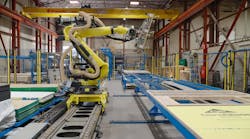A fundamental problem with building controls today is the use of PID (proportional/integral/derivative) control as a primary means for regulating the operation of building-system components. PID control was never well-suited for HVAC control. Now that we have robust digital control systems, it is imperative that we make a change because comfort, efficiency, and control stability are all adversely affected by the continued widespread application of PID control to HVAC systems.
But what replaces PID control? To answer this, consider a radiant cooling system. In such systems, cold primary chilled water is typically mixed with warmer return chilled water to obtain a radiant panel supply temperature with a set point maintained just above the current dew point. PID control of the mixing valve is often not stable through all conditions. Much more effective control can be applied using the temperature of the primary and return chilled water along with the fraction of mixing that occurs at various valve positions. These system variables are used to calculate a base valve position. Then a simple but limited time-based error-control regimen can be applied to fine-tune the final valve control signal. With this approach, far more accurate and stable control can readily be achieved over the full range of operating conditions.
Relational control is the broad term I use to describe such methods of control. Relational control is quite simply the method of operating one component in relation to more than one other component or system variable. Relational control developed from my work with the equal marginal performance principle, which has established that achieving optimal energy efficiency of any system composed of multiple energy-consuming components requires each component to be operated in relation to the operation of the others. The stand-alone nature of PID control makes it entirely unsuited for this new understanding of energy optimization.
To see the energy implications of replacing PID with relational control, consider a condensing hot-water boiler and its heating water-supply pump. The boiler efficiency improves when the hot water temperature is reduced. The overall efficiency of the heating-water pump is improved when the pump speed is reduced and the delta T rises. But if we deliver less heating water to improve the efficiency of the pumping system, the hot water temperature from the boiler will have to be increased. This means it operates less efficiently. The equal marginal performance principle teaches us that the boiler and pump are operating optimally together only when a small increment in heating demand will require the same incremental energy cost whether the flow or the hot water temperature is increased. This means that system optimization requires relational control of the system components.
Practically speaking, operating the firing rate of the boiler by PID control of the water temperature and the speed of the pump by a separate PID loop, and then trying to coordinate the operation of the two stand-alone PID controls together to achieve the correct optimal operating relationship at all times is virtually impossible. However, using relational control to coordinate the two components together so that the speed of the pump and the firing rate of the boiler ramp up and down together through a correctly constructed optimization algorithm makes control much simpler, more effective, and more efficient, and also provides far more stable operation for the entire heating system.
Relational control encompasses an ever-increasing number of new multivariable control strategies for the various components and systems that are incorporated into modern HVAC systems. These new strategies for ultra-efficient and effective system operation are crucial to successful modern building operation. If the building system you are designing, constructing, improving or maintaining is operated primarily based on PID set point control, it is already out of date and needs to be upgraded. I encourage you to work to start making the much-needed change to replace most PID control—now.
I invite your thoughts, comments, and good ideas about this article.
Thomas Hartman, PE, is principal of The Hartman Co., Georgetown, TX. He can be reached at 254/793-0120, or by e-mail at [email protected]








